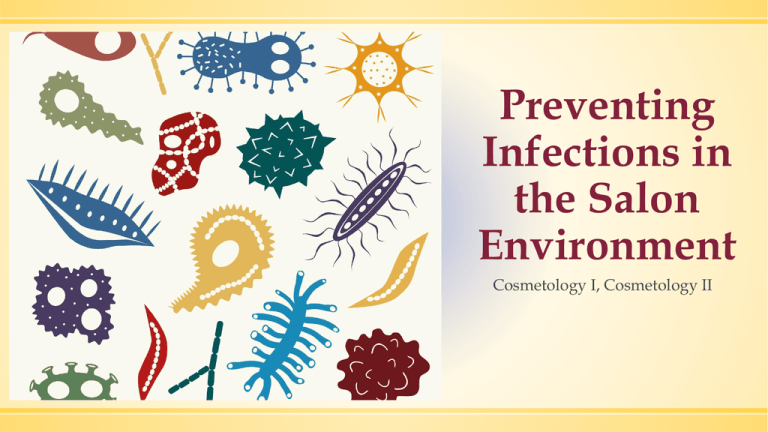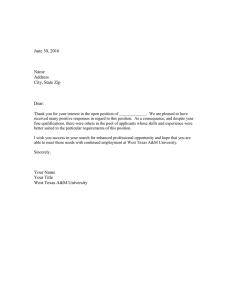
Preventing
Infections in
the Salon
Environment
Cosmetology I, Cosmetology II
Copyright
Copyright © Texas Education Agency, 2015. These Materials are copyrighted © and trademarked ™ as the property
of the Texas Education Agency (TEA) and may not be reproduced without the express written permission of TEA,
except under the following conditions:
1) Texas public school districts, charter schools, and Education Service Centers may reproduce and use copies of the
Materials and Related Materials for the districts’ and schools’ educational use without obtaining permission
from TEA.
2) Residents of the state of Texas may reproduce and use copies of the Materials and Related Materials for
individual personal use only, without obtaining written permission of TEA.
3) Any portion reproduced must be reproduced in its entirety and remain unedited, unaltered and unchanged in
any way.
4) No monetary charge can be made for the reproduced materials or any document containing them; however, a
reasonable charge to cover only the cost of reproduction and distribution may be charged.
Private entities or persons located in Texas that are not Texas public school districts, Texas Education Service Centers,
or Texas charter schools or any entity, whether public or private, educational or non-educational, located outside the
state of Texas MUST obtain written approval from TEA and will be required to enter into a license agreement that
may involve the payment of a licensing fee or a royalty.
For information contact: Office of Copyrights, Trademarks, License Agreements, and Royalties, Texas Education
Agency, 1701 N. Congress Ave., Austin, TX 78701-1494; phone 512-463-7004; email: copyrights@tea.state.tx.us.
Copyright © Texas Education Agency, 2015. All rights reserved.
2
What is an Infection?
The invasion of body tissues by disease-causing pathogens
Copyright © Texas Education Agency, 2015. All rights reserved.
3
Types and
Classifications
of Bacteria
Bacteria and Viruses
Copyright © Texas Education Agency, 2015. All rights reserved.
4
Bacteria
▪ One celled microorganisms
that have both plant and
animal characteristics
▪ Microscopic in size
▪ Can exist almost anywhere
Copyright © Texas Education Agency, 2015. All rights reserved.
5
Types of Bacteria
Nonpathogenic
Pathogenic
▪ Harmless bacteria
▪ Yogurt, cheese, medicines
▪ Harmful bacteria
▪
▪
▪
▪
▪
▪
Cocci
Staphylococci
Streptococci
Diplococci
Bacilli
Spirilla
Copyright © Texas Education Agency, 2015. All rights reserved.
6
Viruses
▪ Live by penetrating and
taking over cells
▪ Resistant to antibiotics
▪ Some vaccines are
available
▪ Common virus in salons
▪ HPV-Human Papilloma Virus
Copyright © Texas Education Agency, 2015. All rights reserved.
7
Hepatitis and
AIDS
Bloodborne Pathogens
Copyright © Texas Education Agency, 2015. All rights reserved.
8
Bloodborne Pathogens
▪ Carried in the body by blood
or body fluids
▪ Hepatitis A
▪ Hepatitis B
▪ Hepatitis C
▪ Human Immunodeficiency
Virus (HIV)
Copyright © Texas Education Agency, 2015. All rights reserved.
9
Fungi
▪ Microscopic plant parasites that
include molds, mildews and yeasts
▪ Tinea barbae
(barber’s itch)
▪ Tinea capitis
▪ Tinea pedis
Copyright © Texas Education Agency, 2015. All rights reserved.
10
Vegetable and
Animal Parasites
Copyright © Texas Education Agency, 2015. All rights reserved.
11
Parasites
▪ Organisms that need a host to
survive
▪ Can live on or inside of humans and
animals
▪ Pediculosis capitis (head lice)
▪ Scabies (itch mite)
▪ Both contagious
Copyright © Texas Education Agency, 2015. All rights reserved.
12
Universal
Precautions
Agencies and Responsibilities
Copyright © Texas Education Agency, 2015. All rights reserved.
13
OSHA’s
Bloodborne
Pathogens
Standards
Treat all human blood and
other potentially infectious
material (OPIM) as if known
to be infectious for
bloodborne pathogens
Copyright © Texas Education Agency, 2015. All rights reserved.
14
Federal Agencies
▪ Occupational Safety and
Health Administration (OSHA)
▪ Occupational Safety and
Health Act of 1970
▪ Hazard Communication
Standard (HCS)
▪ Material Safety Data Sheet
(MSDS)
▪ Environmental Protection
Agency (EPA)
Copyright © Texas Education Agency, 2015. All rights reserved.
15
State Agency
▪ Texas Department of Licensing and
Regulation (TDLR)
▪ TDLR's Mission
The mission of the Texas
Department of Licensing and
Regulation is to honor the
trust of all Texans, ensure
public safety and consumer
protection, and provide a fair
and efficient regulatory
environment.
(image from website)
http://www.tdlr.texas.gov/
Copyright © Texas Education Agency, 2015. All rights reserved.
16
Responsibilities
▪ Never take shortcuts for
cleaning and disinfecting
▪ Follow state and federal laws
▪ Keep your license current
▪ Check TDLR website
frequently for updates to rules
and regulations
Copyright © Texas Education Agency, 2015. All rights reserved.
17
Cosmetology
Services in a Safe
Environment
Decontamination Methods
Copyright © Texas Education Agency, 2015. All rights reserved.
18
Decontamination Method #1
▪ Two step process
▪ Cleaning tools
1. Wash with soap and warm
water, then scrub with a
clean and disinfected nail
brush
2. Use an ultrasonic unit
3. Use a cleaning solvent
▪ Disinfect
Copyright © Texas Education Agency, 2015. All rights reserved.
19
Decontamination Method #2
▪ Two step process
▪ Cleaning tools
▪ Sterilizing
▪ autoclaves
Copyright © Texas Education Agency, 2015. All rights reserved.
20
Disinfectants
▪ Appropriate for salon use:
▪ Quaternary Ammonium
Compounds (quats)
▪ Phenolics
▪ Bleach
Copyright © Texas Education Agency, 2015. All rights reserved.
21
Choosing a Disinfectant
▪ Be readily available
▪ EPA approved and environmentally friendly
▪ Inexpensive
▪ Must be efficacious
▪ Nontoxic and nonirritating
▪ No odor and noncorrosive
▪ Sustainable for at least a week or more
Copyright © Texas Education Agency, 2015. All rights reserved.
22
Copyright © Texas Education Agency, 2015. All rights reserved.
23
Review
1.
What is an infection?
2.
How can infections be transferred?
3.
Where can bacteria exist?
4.
Name a harmless bacteria
5.
What is a common viral infection in salons?
6.
How are hepatitis and HIV carried in the body?
7.
What are parasites?
8.
What are universal precautions?
9.
What are the steps for the decontamination method #1?
10. What should you do before and after working with a client?
Copyright © Texas Education Agency, 2015. All rights reserved.
24
Copyright © Texas Education Agency, 2015. All rights reserved.
25
References and Resources
Images:
▪ Microsoft Office Clip Art: Used with permission from Microsoft. (Slides 5, 7, 9, 12, 19, 20, 21)
▪ Shutterstock™ images. Photos obtained with subscription. (Slides 1, 3, 4, 8, 10, 11, 13, 15, 17, 18, 23, 25)
Textbook:
▪ Frangie, C. M. (2012). Milady standard cosmetology. Clifton Park, NY: Cengage Learning.
▪ Backe, J. (2016). Milady standard cosmetology. Clifton Park, NY: Cengage Learning.
▪ Salon fundamentals. (2012). Evanston, IL: Pivot Point International.
Websites:
▪ Centers for Disease Control and Prevention (CDC)
Keeping hands clean is one of the best ways to prevent the spread of infection and illness.
http://www.cdc.gov/features/handwashing/
▪ Occupational Safety and Health Administration (OSHA)
Nail Salon Workers: Stay Healthy and Safe While Giving Manicures and Pedicures
https://www.osha.gov/pls/publications/publication.html
▪ Texas Department of Licensing and Regulations
The leader in public service, customer satisfaction, and innovation
http://www.tdlr.texas.gov/index.htm
▪
United States Environmental Protection Agency (EPA)
Guidance from the EPA and the Centers for Disease Control and Prevention (CDC)
http://www.epa.gov/pesticides/factsheets/pedicure.htm
Copyright © Texas Education Agency, 2015. All rights reserved.
26

